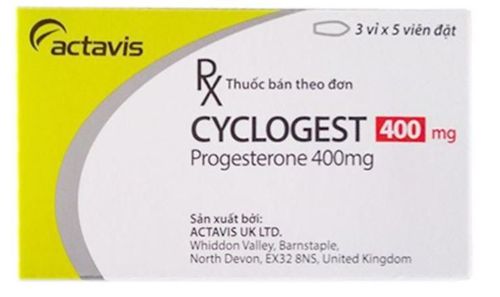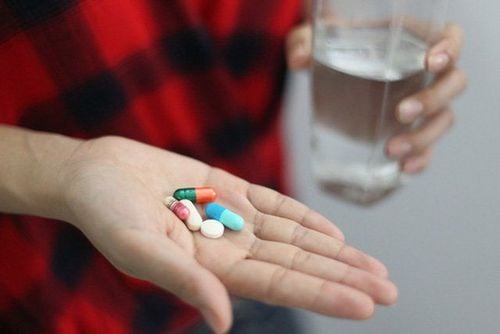This is an automatically translated article.
Brexanolone has the international trade name Zulresso. Brexanolone is used to treat the symptoms of postpartum depression. Let's find out what Brexanolone is and how to use it in the article below.
1. What is Brexanolone?
What is Brexanolone? Brexanolone is classified as an antidepressant, and was approved by the US Food and Drug Administration (FDA) in 2019 for the treatment of symptoms of postpartum depression. The FDA requires that patients only use Brexanolone in a certain medical facility and under the supervision of medical personnel.
Dosage form: solution for intravenous injection, each ml contains 5mg Brexanolone. Packaging form: box of 1 bottle of 20ml.
2. Effects of the drug Brexanolone
Brexanolone is a synthetic version of allopregnanolone found in the brain, ovaries, and placenta. Allopregnanolone levels increase during pregnancy and then decrease after the baby is born. Alterations in allopregnanolone levels lead to depression and anxiety. Thus, Brexanolone acts to modulate the body's stress response by binding to GABA receptors and re-establishing brain activity associated with manifestations of postpartum depression.
3. Dosage and how to use the drug Brexanolone
Brexanolone is not usually available for use, you need to be registered under a special dosing program to be treated with this medicine, because of the risks of taking it.
Dosage:
Hour 0 – 4: 30 mcg/kg/hr Hour 4 – 24: 60 mcg/kg/hr Hour 24 – 52: 90 mcg/kg/hr Hour 52 – 56: 60 mcg/kg/hr 56 – 60: 30 mcg/kg/hour Administration: continuous intravenous infusion. Total duration of treatment: 60 hours (2.5 days)
Brexanolone may cause excessive sedation, so treatment should be started early in the day. Also monitor the patient continuously (breath rate, blood pressure, oxygen levels, and other vital signs) throughout the infusion period.
For patients with renal failure:
Mild to severe renal impairment (glomerular filtration rate 15 - 89ml/min/1.73m2): no dosage adjustment is recommended. Severe renal failure (glomerular filtration rate less than 15ml/min/1.73m2): should not be used. For patients with hepatic impairment: No dosage adjustment is recommended.
Note: during infusion, if the patient shows signs of hypoxia, the drug should be stopped immediately and the infusion should not be resumed once the hypoxia has resolved.
What to do if you forget a dose of Brexanolone?
Brexanolone is used as a single dose in a medical facility and under medical supervision, so missed doses are rare. What to do in case of an overdose of Brexanolone?
An overdose of Brexanolone can cause severe drowsiness, fainting, or slow breathing. Therefore, when seeing a patient with abnormal signs during the course of taking the drug, it is necessary to immediately notify the medical staff for timely treatment.
4. Undesirable effects when using the drug Brexanolone
In addition to the necessary treatment effects, the drug Brexanolone may cause some unwanted effects. However, these side effects may go away during treatment as your body adapts to the medicine.
Common: dry mouth Uncommon: belching, diarrhea, feeling of warmth, heartburn, indigestion, pain in the mouth or throat, redness of the face, neck, arms, upset stomach, uncomfortable feeling or pain. In addition, Brexanolone may also cause undesirable effects that require immediate medical attention, including:
Common: dizziness or lightheadedness, drowsiness, fainting, sensation of constant movement of oneself or one's surroundings, a sense of relaxation and calm, a sense of rotation. Uncommon: rapid or irregular heartbeat or pulse, loss of consciousness.
5. Drug interactions
Other drugs when used concurrently may affect the absorption rate, effects, and side effects of Brexanolone, including prescription and over-the-counter medicines, vitamins, and herbal products. Therefore, you need to tell your doctor about all current medicines you are taking and any medicines you start or stop using. Drugs that may interact with Brexanolone include:
Adderall (amphetamine/dextroamphetamine) Adderall XR (amphetamine/dextroamphetamine) BC Original (aspirin/caffeine) Klonopin (clonazepam) Pristiq (desvenlafaxine) Topamax (topiramate) Tosymra (sumatriptan) Vitamins D3 (cholecalciferol) Vitamin K (phytonadione) Food interactions:
Using brexanolone with ethanol may increase side effects such as dizziness, drowsiness, confusion, and difficulty concentrating. Some people may also have impaired thinking, judgment, and motor coordination. Therefore, you should avoid or limit alcohol use while being treated with Brexanolone.
6. Some notes when using the drug Brexanolone
Taking Brexanolone during pregnancy can harm an unborn baby. Therefore, it is important to tell your doctor if you are pregnant or plan to become pregnant. It may not be safe for a nursing mother to use Brexanolone while breastfeeding. Therefore, it is important to let your doctor know if you are breastfeeding. Do not use more than the recommended dose of Brexanolone and avoid driving, operating machinery, or engaging in potentially hazardous activities that require alertness and motor coordination until you know how it affects you. how. Brexanolone is a single dose prescribed by doctors for the treatment of postpartum depression. Therefore, to ensure safety and avoid side effects, patients should strictly follow the instructions of the doctor and medical staff performing the infusion.
Follow Vinmec International General Hospital website to get more health, nutrition and beauty information to protect the health of yourself and your loved ones in your family.
Reference source: drugs.com













